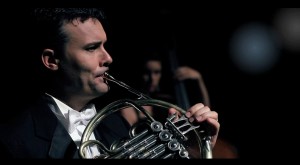Story Behind the Technique
 The story behind my embouchure technique can be traced back to a lesson with Dale Clevenger at Northwestern where I was playing the Franz Strauss “Nocturno” for him. We were working on the concept of “thick air” and after playing one loud passage, Dale exclaimed, “That’s it!” In thinking about what I did so I could recreate it, I realized that I opened up the center of my lips, blew a little more air with my lips more forward.
The story behind my embouchure technique can be traced back to a lesson with Dale Clevenger at Northwestern where I was playing the Franz Strauss “Nocturno” for him. We were working on the concept of “thick air” and after playing one loud passage, Dale exclaimed, “That’s it!” In thinking about what I did so I could recreate it, I realized that I opened up the center of my lips, blew a little more air with my lips more forward.
Years later as I was learning to apply this “thick air” concept on the job, I was still fluctuating back and forth with consistency and accuracy. Then, as a teacher, I observed the importance of the jaw/chin/bottom lip relationship. I noticed with a particular student (who had a crunched up chin muscle and nasal sounding, pinched tone) that getting him to flex his chin muscle downward (which pulled his bottom lip down) his tone immediately opened up (and went flatter).
Through much more experimentation, I put the concept of “thick air” together with aligning the air stream with the chin/jaw/bottom lip to the bottom of the note. This created the basis for Video 7, “connecting to the horn,” which is the foundation of my technique. Once you are connected to the horn on one note, moving from that note to other grooves/notes can then be mastered through the trill technique and is explored in Video 10, “Trills.”
I also learned from my students that placing the bottom of the mouthpiece in the pink creates a pinched sound and also sabotages the chin muscle’s ability to pull down the bottom lip. Placing the MP below the bottom lip line enables the chin/jaw to pull the bottom lip down to open the sound and give much needed control in finding/resting on the bottom of the note/groove. This became my number 1 “Must Have” because without it, the other techniques were limited, sabotaged, prevented, etc.
The tongue needed to be down so the air could align with the bottom of the groove (pitch and tone reasons).
The angle of the mouthpiece needed to be down so the top lip would be free to buzz. The 2/3 upper 1/3 lower lip ratio was confirmed again and again by a warmer tone than the 1/2-1/2 or 1/3 upper 2/3 lower (very bright sound) mouthpiece position.
I now have refined/simplified the technique and trace the fundamental structure back to the chin muscle and how it connects the bottom lip to the jaw bone. Once the chin muscle is flexed downward, the jaw can then control the bottom lip.
Through using a jaw vibrato, one can find and feel the bottom, center and upper parts of a note. Staying in the open vibrato position, one can feel/find the bottom of the note and then rest the air cushion on the bottom of each note. Then the lips can further relax now that one is trusting/resting on the bottom of the note, and no longer needs to hold up the note. Ahh, no more swimming around in the middle of the note. The intonation/slide position is now determined by the temperature/humidity in the room and not by a pinching embouchure.
Through mastering the connection to the note/groove and one’s trills, all slurs can be smoother and with a fuller, more open tone. Through keeping the air column full and resting on the bottom of all notes and using the jaw/chin to connect to the bottom of each groove, one’s playing becomes much more solid, predictable, and dependable. One can now connect directly to the horn and can accomplish much more than floating around in the middle of the note. With extreme dynamics, ppp – fff – ppp, the intonation can be the same because one is resting down on the bottom of the groove. The tone can open up/blossom in loud passages since one is resting on the groove instead of pinching and forcing.
I trace all my advanced horn embouchure techniques back to the “5 Must Have Techniques” that I describe in Video 1. Please see the Order Page for more information on the videos and the McAfee Method horn book. I hope you will find instant, positive and predicable results through applying these techniques so you can express your unique musical message to your audience.
I give credit to Dale Clevenger for his artistry and technical concepts that originally provoked my discoveries. I am still trying to master the concepts he set before me back in college. I am grateful to Dr. James H. Winter for his personal presence, rich tone quality and sense of being apart of an important lineage of horn players.




